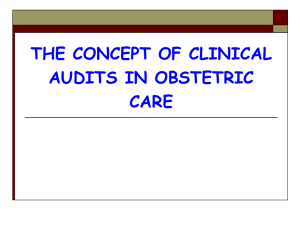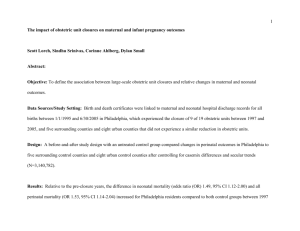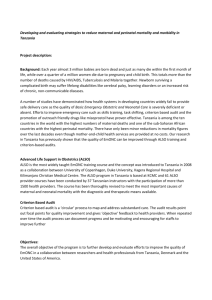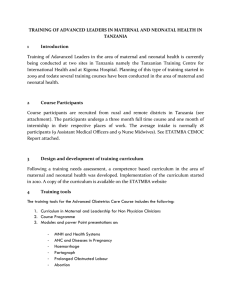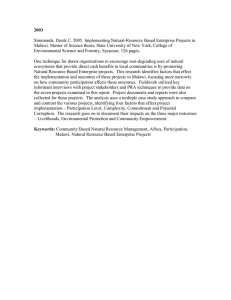MS 18 – Third year report on audit and development... indicators (WP2)
advertisement
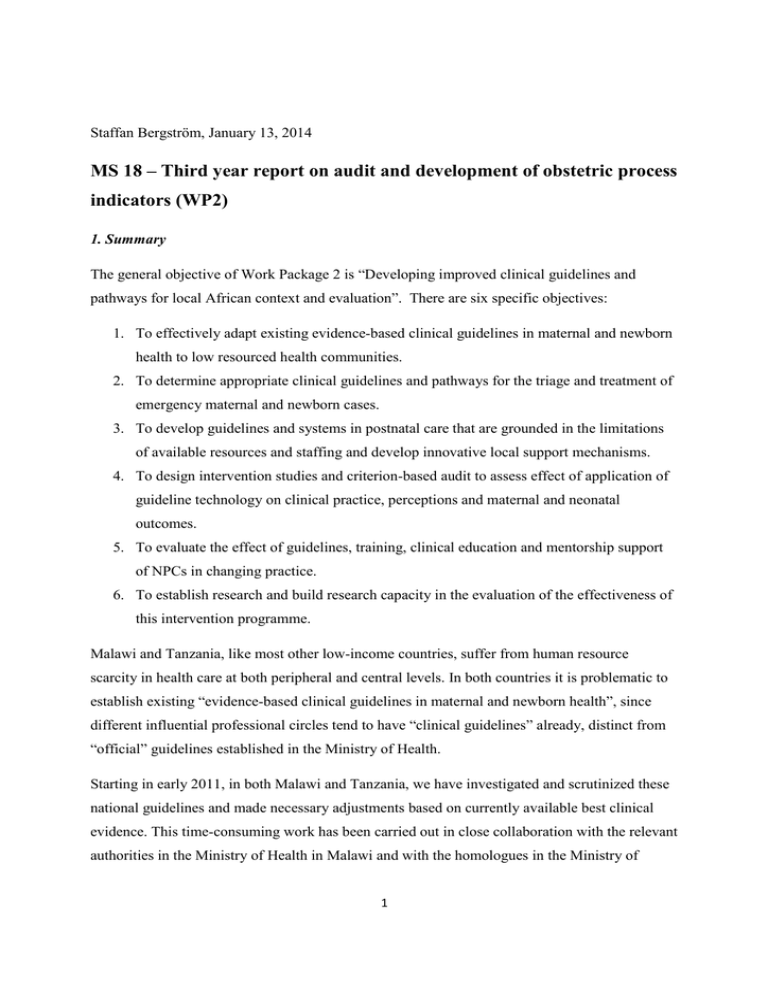
Staffan Bergström, January 13, 2014 MS 18 – Third year report on audit and development of obstetric process indicators (WP2) 1. Summary The general objective of Work Package 2 is “Developing improved clinical guidelines and pathways for local African context and evaluation”. There are six specific objectives: 1. To effectively adapt existing evidence-based clinical guidelines in maternal and newborn health to low resourced health communities. 2. To determine appropriate clinical guidelines and pathways for the triage and treatment of emergency maternal and newborn cases. 3. To develop guidelines and systems in postnatal care that are grounded in the limitations of available resources and staffing and develop innovative local support mechanisms. 4. To design intervention studies and criterion-based audit to assess effect of application of guideline technology on clinical practice, perceptions and maternal and neonatal outcomes. 5. To evaluate the effect of guidelines, training, clinical education and mentorship support of NPCs in changing practice. 6. To establish research and build research capacity in the evaluation of the effectiveness of this intervention programme. Malawi and Tanzania, like most other low-income countries, suffer from human resource scarcity in health care at both peripheral and central levels. In both countries it is problematic to establish existing “evidence-based clinical guidelines in maternal and newborn health”, since different influential professional circles tend to have “clinical guidelines” already, distinct from “official” guidelines established in the Ministry of Health. Starting in early 2011, in both Malawi and Tanzania, we have investigated and scrutinized these national guidelines and made necessary adjustments based on currently available best clinical evidence. This time-consuming work has been carried out in close collaboration with the relevant authorities in the Ministry of Health in Malawi and with the homologues in the Ministry of 1 Health and Social Welfare in Tanzania. Both countries’ guidelines have their focus on maternal and newborn care during pregnancy, childbirth and the postnatal period. A specific problem is the fact that the best available evidence implies a significant cost (drugs, emergency supplies, equipment etc.), which many times impedes the practical performance according to such guidelines. Hence, evidence-based best clinical practice must frequently be set aside due to lack of resources or lack of funds for needed material. Existing, established clinical guidelines for maternal and neonatal care have recently been revised by the Ministries of Health in both Tanzania and Malawi but we found possibilities to add to the last revision updated clinical evidence, which can make interventions more efficient at an affordable cost. Regular, criterion-based audit sessions have been initiated as part of ongoing in-service staff training. During 2013 we have further developed a number of obstetric process indicators, like facility-based deliveries as a percentage of expected deliveries in an assumed catchment area, percentage of cesarean sections of all facility-based deliveries and also tentatively case fatality rates per morbidity. Over the last 12 months the ETATMBA project has continued to improve the model archive of case notes and partogrammes, which constitute the very basis of clinical audit in all facilities in Tanzania where the project has been implemented. Malawi Sexual and Reproductive Health Guidelines are generic in that they relate to all levels of health workers in the area of reproductive health. During 2013 these guidelines are increasingly supplemented by protocols on the management of various sexual and reproductive health conditions. For the purposes of this project the Department of Reproductive Health decided that the guidelines did not need to change but the protocols needed to be updated to be in line with current thinking and new technologies on the management of reproductive health conditions. As we have noted earlier in reports the Malawi guidelines cater for all SRH health cadres. Job aides are then developed based on these guidelines for the various SRH cadres. For NPCs the job aides are in the form of obstetric protocols on the management of the major causes on maternal and neonatal morbidity with the objective of contributing to the achievements of MDGs 4 and 5 as the management of the top five causes of maternal and neonatal morality are covered. The NPC training in Malawi emphasizes clinical audits and the professional projects. To undertake these assignments the NPC students use these protocols. The Ministry of Health has since printed the protocol charts and placed them in all obstetric units in the country. 2 Protocols in Malawi are produced in book form and then copied to wall charts that are posted in relevant rooms and sites where those services are provided for quick reference. Consultation with the reproductive health department led to a consensus agreement that the protocols should be directed to the main causes of maternal and neonatal morbidity and mortality in Malawi. Referring to the latest Malawi Demographic and Health Survey, the major causes of maternal and neonatal mortality have been identified, from which the top five causes of maternal mortality and five major causes of neonatal mortality were selected to be addressed in the protocols. It was decided that the protocols would be directed to the clinicians, the majority of whom in Malawi are Non-Physician Clinicians (NPCs), also known as Clinical Officers. These consultations took place with the department of Reproductive Health. The outcome was the list of reproductive health conditions whose management protocols needed to be upgraded was followed by literature review. The ETATMBA project personnel notably by Dr Chisale Mhango, and the two visiting registrars employed by the project, Dr Saliya Chipwete and Dr Gregory Eloundou, conducted the literature review. It was conducted alongside reference to the WHO Guidelines on the Management of Pregnancy and Maternal and Child Health. The old protocols were then updated by the three project personnel and edited by Dr Mhango. The draft was circulated to all project personnel for comment and was finalised by Dr Mhango. The final document was then passed on to the new head of Reproductive Health, Ms Fannie Kachale, for processing. At this point, it emerged that another research project (USAID, which had sponsored development of the earlier guidelines) had also updated the protocols. The Ministry of Health did not contact the ETATMBA team to inform them that this exercise had taken place. The project team reviewed this new set of protocols and found only minor differences to the ETATMBA updates. A few small revisions were suggested by Dr Chipwete, but by this time, the Department of Reproductive Health had already sent the version produced by the USAID project to the USA for printing. In view of the additional and unnecessary expense, the guidelines and protocols were not reprinted. However, it should be noted that the revisions suggested by the ETATMBA team corresponded in all but a few small details to the revisions produced by the USAID team. During 2013 the Ministry of Health and Social Welfare (MoHSW) in Tanzania has started a process of thorough updating of existing guidelines entitled “Emergency Obstetric Care Job 3 Aid” (dated December 2008). The MoHSW considers the development of clinical guidelines a dynamic process at several levels and at several points in time. The dynamic nature is related to three important background factors. Firstly, existing perceptions of “best practices”, in any clinical field, should always be challenged and beliefs be avoided and reliable evidence sought. Secondly, “best practices” prescribed by the scientific literature should also be challenged due to the fact that there are serious material resource constraints in low-income countries like Tanzania. These constraints often rule out “best practices” as non-affordable and beyond reach from a district health budget perspective. Thirdly, very scarce human resources counteract implementation of “best practices” due to unavailable senior staff for clinical audit. This multifactorial reality makes adaptation of internationally agreed upon evidence-based guidelines problematic from a mere poverty perspective. For pregnancy and delivery complications the MoHSW thus established already five years ago an updated list of norms at different health facility levels. It was already then understood that the antenatal “risk” approach is an insufficient concept that does not address prevention of maternal mortality in a comprehensive way. It was stated “although some of these complications cannot be prevented or reliably predicted, they can be treated if appropriate emergency care is timely provided. To effectively reduce maternal deaths Emergency Obstetric Care (EmOC) should be available, accessible, affordable and of good quality”. During 2013 the ETATMBA project in Tanzania has accompanied and given significant input into the updating of Emergency Obstetric Care Job Aid. The document to be updated is intended to serve as a practically useful and quick tool to health care providers. As such the tool would enhance maternity care providers ability to diagnose, manage and - if needed - refer obstetric complications. With new development in medical sciences, it created the insight of the need for regularly revising this document in the effort to improve the quality of emergency obstetric care. The tool is intended for several levels of health staff: doctors, assistant medical officers, clinical officers, nurse-midwives and other health professionals responsible for providing emergency obstetric care at the dispensary, health centre and hospital levels. The updated Emergency Obstetric Care Job Aid is to be organized by obstetric complications or conditions. These complications are listed according to their prevalences in Tanzania, from those occurring most commonly to those occurring least frequently. 4 For each obstetric complication or condition, the following information will be presented: 1. A definition of the complication, based on clinical diagnosis; 2. Symptoms with which the client may present; 3. Clinical signs that enable providers to identify and diagnose the complication; and 4. Detailed guidance for managing the complication according to the level of health care i.e. dispensary/health centre and hospital 5. Clinical flow charts for the major obstetric complications are presented at the end of each complication, where appropriate. The flowcharts illustrate the sequence of steps involved in diagnosing and managing complications and are designed to assist providers in taking quick actions to manage the complication or to stabilize and refer the case as appropriate. In the ETATMBA project in Tanzania we have been through all details of this document. We have also spent much time to trace relevant published and unpublished studies on all complications. We have then made proposals of updating of each norm according to available evidence with adaptation to known resource constraints. In parallel with the ETATMBA project efforts in Tanzania during 2013 to develop and update the Emergency Obstetric Care Job Aid the Reproductive and Child Health Section of the MoHSW has noted that several other stakeholders working in maternal health have similar ambitions to update existing guidelines. All inputs to improve the “Job Aid” have gradually been provided to the “Safe Motherhood Working Group” (SMWG), led by the National Coordinator of Safe Motherhood in the MoHSW, Dr K Winani. The SMWG is currently compiling all these stakeholders’ inputs in order to authorize an official, new version of the Emergency Obstetric Care Job Aid to be available in late 2014. A number of times the ETATMBA project team responsible for WP 2 (Karolinska Inst.) has tried to get authorization from the Tanzanian Ministry of Health and Social Welfare to carry out the evaluation of our elaborated updated Guidelines according to objectives. We have finally been forced to accept that the Ministry openly objects to such an evaluation given the fact that the 5 updated Emergency Obstetric Care Job Aid will be published in late 2014 (see letter from MoHSW, Enclosure 1). 2 Clinical audit: significant results to consolidate progress 2.1 Tanzania As indicated in previous reporting there are five clinical entities that have been given highest audit priority: 1. Maternal deaths 2. Fetal deaths during labor (“fresh stillbirths”) 3. Early neonatal deaths (within first 24 hours after birth) 4. Caesarean sections 5. Vacuum extractions During 2013 the ETATMBA project has given continuous emphasis to clinical audit. The overload of clinical work with increasing number of deliveries makes audit efforts an uphill struggle both for the staff and for the supervisors. There is reason, however, to sustain audit as a very important tool for improved quality of care with focus on both outcome and process indicators. 2.1.1 Clinical audit of interventions: assessment both of outcome indicators and process indicators In the ETATMBA project in Tanzania the audit focus was initially on outcome indicators, above all maternal mortality. Gradually the scope was widened to encompass two more outcome entities listed above (2.1), intrapartum fetal deaths and early neonatal deaths, both directly related to substandard quality of intrapartum and early postpartum care. However, audit has also been used to scrutinize circumstances around a specific intervention, for instance caesarean section, vacuum extraction, destructive fetal operations etc. We can also use audit in a successful way to scrutinize referrals, by which we can analyze final outcome of patients referred from a peripheral health facility to a hospital. 6 2.1.2 Audit of process indicators The introduction of functional archive boxes (see MS report 15), in which case notes, partogrammes, surgical notes etc are compiled in a systematic way, have enabled the ETATMBA project to follow two fundamental process indicators in emergency obstetric care: caesarean section and vacuum extractions. The archive box is based on the labour ward book with its numbering of patients delivering in the health facility. Each case note, partogramme, surgical note etc. has the same number as the labour ward book number. Immediate marking by the labour ward midwife of each partogramme or each patient-related note with the corresponding number is mandatory. The monthly review of all caesarean sections implies an audit note summarizing observations. If there is no partogramme and no other information written in the patient’s case notes there is no possibility to say that the caesarean section was “justified”. All such cases must be considered “non-justified” until written proof is available to confirm justification. The partogramme is thereby the most important tool for the audit of these two process indicators. However, the mere existence of a partogramme does not mean that a partogramme is completed in a way that is meaningful and action-oriented. For instance, there should be regular auscultations of the fetal heart rate after contractions and also regular, proper filling-in of the cervical dilatation. There should also be a clear indication whether and when the membranes have ruptured or whether artificial rupture of membranes has been performed. The strength and the duration of contractions should be possible to assess. The auditing physician cannot say that a caesarean section is justified in the absence of documentation (partogramme or similar document). The management (process) of other emergencies, for instance eclamptic cases can also be audited in this way. Eclampsia in itself does not imply caesarean section. Likewise, “prolonged labour” or so-called “obstructed labour” does not imply necessity of caesarean section unless other interventions have been considered. In dynamic dystocia it is unfortunately common to see erroneous caesarean sections without any attempt to augment labour. The partogramme is also an important tool for the audit of assisted vaginal deliveries. To reintroduce vacuum extraction in the ETATMBA project in Tanzania has been another uphill struggle. Both the cervical dilatation and the descent of the presenting fetal part are given 7 attention in this audit. For instance, a proper assessment can be made whether a vacuum extraction could have been considered at caesarean section audit. 2.2 Malawi Due to different background circumstances the ETATMBA project activities are differently performed in Malawi than in Tanzania. During 2013 in Malawi the focus has continued to be on the major causes of maternal and neonatal deaths: 1. Postpartum haemorrhage 2. Puerperal sepsis 3. Eclampsia 4. Obstructed labour and 5. Early neonatal deaths 2.2.1 Main objective Since changes in maternal mortality may not be possible to demonstrate in the span of a three year project, the objective of the project is to reduce neonatal deaths, fresh stillbirths due to birth asphyxias and fetal distress in the project districts, which shall be compared with the same in the control districts. 2.2.2 Audit-specific objectives All ETATMBA students undertake audits, which count towards their BSc degrees. This is the evidence the project has that students are applying the knowledge and skills they have acquired through the training in the project. To find out is the magnitude of problems identified in the maternal and newborn safe motherhood outcomes. To detect major contributing factors to the identified problems To set standards and make recommendations against contributing factors to these problems and let midwives, clinicians and community follow them for improvement. To re-audit after 3 months and see if the established standards are improving health care quality to pregnant mothers in labour and if so sustain them. 8 Different students have different audit topics but all around the five areas listed above. 2.2.3 Re-audit specific objectives The follow-up of outcomes of the audit is addressed in the repeat audit with these aims: To find out if the recommendations set in the first audit were successful. To measure the gap between the current practice and the practice after introducing the audit standards (if any improvement in patient care). 2.2.4 To measure changes in maternal and neonatal outcomes. Conclusion and recommendations During 2013 it has been verified that this criteria-based audit can improve health care in fetal monitoring during labour, asphyxiated newborn resuscitation, antenatal clinic counseling on dangers of using homemade medicine and home delivery on possible baby outcome and urgent clinician review of emergency obstetric cases despite limited resources. The busiest maternity unit in the Malawi Capital Lilongwe has two ETATMBA students. This unit has just reported that it has not experienced a maternal death in the past 6 months; the situation before was an average of two maternal death a month. If our District Health Officer can encourage and give support to clinical officers and nurses to conduct several clinical audits, there can be a great improvement in health care services using the already available but just ignored standards of care at a low cost. Teaching fellow staff how to conduct a clinical audit will make nurse midwives and clinicians realize its importance and how interesting it is in improving clinical health services. For future improved patient care there is a need to work as a team and conduct several clinical audits, implement and sustain them. We have confirmed in 2013 that there is a need to execute ownership of the audit activity for its sustainability and keep on reminding each other. Several factors can counteract this sustainability: frequent staff transfers (both in and out), departmental frequent rotations of staff members and some situations whereby staff members feel demoralized due to lack of being appreciated on their efforts to improve health services by the community and hospital management team. All these factors interrupt the progress of improved services. The already 9 implemented recommendations will make it easier for the new staff to catch up with the recommended practice. For the health centers we are still looking forward at how best they can be handled so that we move together. The main problem with health centers is transport issue due to persistent fuel shortages. 3 Process indicators: significant results 3.1 Tanzania The above-mentioned innovative audits of the two process indicators (caesarean sections and vacuum extractions) have brought much useful information that has been fed back to staff. An intriguing consequence of the caesarean section audit is that the ETATMBA project in Tanzania has cast doubt on two much used process indicators: CFR (case fatality rate) and met need. 3.1.1 CFR During 2013 the ETATMBA project in Tanzania has tried to introduce an improved registration of obstetric morbidities. Such a morbidity registration is a prerequisite for any meaningful use of CFR as a process indicator. Case fertility rate is presented as a good expression of a “process” in the WHO standard of process indicators. CFR is, however, a very difficult parameter to use in practice as an indicator of “process”. The denominator, the aggregate obstetric morbidity, is most often very poorly registered in labour ward books (denominator error) implying that we have an erroneously inflated case fertility rate in facilities with poor morbidity registrations but with better mortality registration. The only way out of this dilemma is to be much more careful in distinguishing case fatality rates specifically per morbidity (for instance eclampsia, post partum hemorrhage, obstructed labor etc). If this is not the case it is almost impossible both to analyze case fertility rate retrospectively and even prospectively, unless the morbidity registration is not improved very significantly. This would require special training of health staff in diagnostic accuracy. The ETATMBA project in Tanzania has tentatively embarked upon such improved morbidity registration to enhance the value of CFR as process indicator. 10 3.1.2 Met need of emergency obstetric care If there is no proper understanding of the pitfalls of using the concept of “met need” it can be used in a simplistic and erroneous way for two reasons. Firstly, in the distinction between the alleged (calculated) “catchment” area and the real (observed) “catchment” area. Secondly, in the statistical distinction between the “allegedly met” need and the “really met” need. Firstly, empirically, the real catchment area tends to increase when rumours are spread about the establishment of an attractive setting in health facility. Such a development implies significant flooding of patients from a geographical area well beyond what has been assumed to be the “catchment area”. This means that the calculations of “met need” is problematic and has to take into account the risk of attraction of patients far outside the assumed (alleged) “catchment area”. This leads to a denominator error by using an erroneous (alleged) area of recruitment of patients. When non-physician clinicians (AMOs in Tanzania) are trained to master also complicated CEmOC cases there is a risk of a “local pandemic of cesarean sections” at the expense of other methods, for instance assisted vaginal delivery. We have noted in some facilities that this upsurge of cesarean sections, many of which are non-justified have substandard clinical indications. It is normally assumed that the optimum percentage of cesarean sections of all births should be in the range of 5-15%. This can be questioned, however, and there are examples of settings with less than 5% cesarean sections with the maternal mortality of 20 per 100,000 live births and perinatal deaths less than 20 per 1000 total births. Therefore, we have been active in introducing clinical audit of all cesarean sections and all vacuum extractions as a better tool to evaluate quality of comprehensive emergency obstetric care. Audits of the process indicators caesarean sections or vacuum extractions thereby constitute invaluable tools. Secondly, “met need” is often erroneously considered an expression of prevalence of obstetric complications. There is an assumption that caesarean sections (per se) express “met need”. In the detailed audit of caesarean sections we have, however, demonstrated that the proportion of clearly unjustified caesarean sections may reach 30-40% or - occasionally - even much higher levels. An unjustified caesarean section is, obviously, not an expression of “met need”; rather an expression of substandard quality of obstetric decision-making and unnecessary waste of scarce surgical resources. 11 3.1 Malawi Malawi conducts EmOC needs assessment regularly. The last one was done in 2010. Unmet need for EmOC is assessed by comparing the UN recommendation against what the 14 million Malawians have. The 2010 report revealed that as the UN recommends that there should be at least 5 Emergency Obstetric and Newborn Care (EmONC) facilities for every 500,000 population, at least one of which should provide comprehensive care. Given its population of 14 million, Malawi should have 140 EmONC facilities, out of which 28 should offer services comprehensively. Out of the 89 hospitals that were assessed, only 47% while in health centres only 2% were offering basic emergency obstetric care. Malawi therefore does not have the recommended number of EmONC facilities per 500,000 population. The EmOC assessment also revealed that less than 4% of deliveries in Malawi were by caesarean delivery when WHO recommends a rate of 5-15%. This is because many women who need caesarean section do not get it, since services are not accessible because of distance and inadequate healthcare workforce and also because of shortage of anesthetists. Only 85% of the surveyed facilities had a source of electricity and out of these. This means that emergency care was not available around the clock in many health facilities. The survey further revealed that most health facilities use piped water as their primary source of water. In Government health centres only 60% had piped water. The rest of the health centres were without piped water or boreholes. A total of 2% of Christian Health Association of Malawi (CHAM) health centres reported using a river as their primary source of water. Catchment area Catchment area is used in audits to determine the denominator. The figure is given by the National Statistic Office during Censuses one in 10 years, thereafter the districts estimate themselves. The real problems exist in districts bordered by another country, especially Mozambique, largely because Malawi provides free care and not Mozambique. The result is that the numerator is higher than the denominator in many occasions. 12 Case fatality rate Case fatality rates are not regarded as accurate but they are valued for their revealing temporal changes. The program looks for improvements in the rates on the assumption that the inaccuracies are common to both the pre- and post- intervention periods. 13
